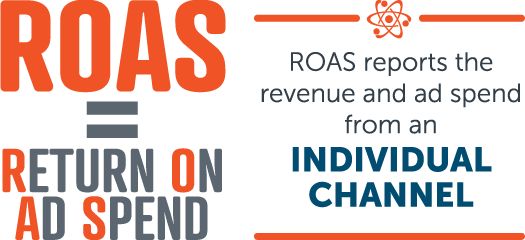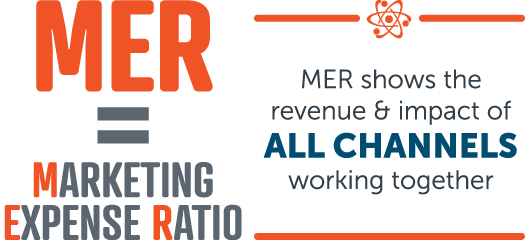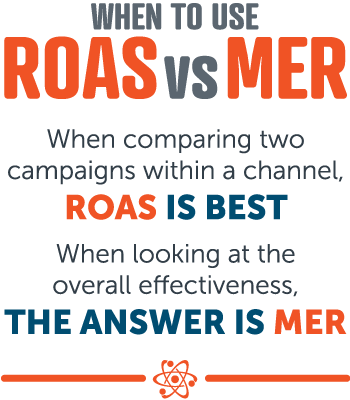ROAS - The Real Downfall of Your Marketing Planning. Is MER the Real Hero?
Marketing today is not what it was 10 years, 5 years, 12 months, or even 10 minutes ago. The digital marketing landscape is changing at a monumentally rapid pace that has never been seen before in the history of marketing. From potential breakups of monopolized companies to unseen historic privacy movements, there has never been a harder yet more data driven time to market. However, therein lies the problem. In a time where data is king, there are very few who really know how to understand and interpret the data, let alone make actionable decisions to do what is best for their marketing as a whole. Enter ROAS….
The Fickle Nature of ROAS
ROAS, or return on ad spend, is the driver of all conversations between brands, agencies, and their digital partners or platforms. Brands and agencies alike gravitate toward only focusing on the return on ad spend per channel that they are running, and for good reason; from what they can see, that is the only data point that tells if a channel is working. All too often the conversation around ROAS goes like this:

All too often the conversation around ROAS goes like this:

CMO to Marketing Platform >
“You have been consistently hitting a 4:1 return on ad spend, though this month it seems we have dropped to 3:1. I know I dropped some other channels, but why are your numbers dropping”

< Marketing Platform to CMO
“When you drop spend somewhere else it takes effect on every other channel, but if you solely care about ROAS being 4:1 we can make that happen within the week”

CMO to Marketing Platform >
“What?!?! How is it that simple?”

< Marketing Platform to CMO
“I have plenty of things I can shift to achieve whatever number you want. If I bolster retargeting efforts or branded keywords, or have special discounts, I can get people to come back without spending more. Or even easier, if I reduce spend, the people that were already in the funnel are still going to convert anyway and in turn our ROAS will skyrocket.
Let’s look at the numbers: we were spending $100k/mo and getting $400k (4:1) normally, but now we’re only getting $300k(3:1). If we drop spend to $50k mid month for the month and still hit $300k revenue, we will achieve 6:1.”

CMO to Marketing Platform >
“6:1? Well that seems like a no brainer…”

< Marketing Platform to CMO
“For the immediate, sure. But consider the long run; by switching to retargeting or special offers, you are only influencing people who are already in your funnel. Eventually they will run out and your prospecting efforts will have dropped, so the ROAS will in turn fall since we aren’t bringing in new clients.
The same goes for dropping budget: If you drop budget to hit a certain ROAS goal, you might look great to your board of advisors that month, but the harder conversation will come in the following months when you are asking for extra money to play catch up”

CMO to Marketing Platform >
“So how do I get ROAS where I need it?”

< Marketing Platform to CMO
“The better question is how do you get your marketing as a whole where you need it. We no longer live in a world where channels are separate entities; every touchpoint is intermingled with each other so we urge advertisers to look at individualized channel revenue. If we are using ROAS as the primary metric, our team will be incentivized to do things that have the opposite/negative impact.”
Enter MER
Marketing Efficiency Ratio, or MER, is a metric that shows the impact of all marketing channels working together, instead of individualized per channel in ROAS models. Similar to TACoS with Amazon marketing, MER lets you weigh your marketing efforts against the total company revenue. With MER you are able to factor in the HALO effect showing the effectiveness of all things working together: the real picture of your full marketing plan at work.

ROAS Calculation
ROAS = Ad Spend Revenue from a particular channel / Ad Spend on that Channel
ROAS looks at ad spend on a 1:1 basis. It does not factor the type of channel or medium that is being run, instead just the spend associated. When comparing the ROAS of a bottom funnel retargeting, paid search, or special offer campaign with a top of funnel / funnel filling campaign (display for example), there will be a vast difference in return on ad spend ratios.
More times than not, this leads to hasty decisions to pause the awareness/top of funnel campaigns, ultimately stunting the company’s ability to grow by only relying on bottom funnel tactics. Pair relying on bottom funnel tactics only with IDFA updates, cookie depreciation, and IOS privacy updates and you are looking at a marketing disaster.
ROAS, however, is still good for calculating individual campaign performance within a channel, but it is NOT effective for comparing channel effectiveness in terms of business growth and efficiency.
MER Calculationn
Marketing Expense Ratio (MER) = Total Revenue for a company / Total marketing or advertising expenses
In short, MER shows how much revenue the company earns for every dollar spent on marketing. A higher MER ratio suggests greater efficiency in advertising spend.

When to USE MER or ROAS
If you are a marketing manager in charge of choosing what channels are producing the most for your company, this can be a tricky balance to strike. When comparing two campaigns within a channel, ROAS is best. When looking at the overall effectiveness that a channel has on your company’s business, the answer is undoubtedly MER. Let’s walk through an example:
Let’s say you start a programmatic campaign for your college’s newest grad program. Programmatic campaigns typically take at least 45 days to ramp up and optimize, so your ROAS on that programmatic campaign is likely to be very low during that early period. However, over the course of that six weeks those ads are driving new users to your site who then:
- Are retargeted on Facebook (increasing ROAS for FB)
- Look for reviews of your program online and end up clicking on a referral website comparing grad programs (increasing ROAS for that referral website)
- Search for your college and click on a Google Paid Search Ad (increasing ROAS for Google)
When they eventually convert, every channel gets credit as they should, thanks to MER. But on a ROAS model it may have only given credit to what touch-point the person last used. Even though their initial exposure was a programmatic ad and their last click was from a Google ad, the MER calculation makes sure every channel gets credit for their contribution in the path to conversion. The MER option clearly shows how every touchpoint is valued and should be calculated when making marketing budget decisions.

How to Implement MER Effectively
Implementing MER effectively in a business requires a systematic approach to collecting comprehensive data. In doing so, a business should analyze all marketing activities, including ad spend and revenue from all channels. They then need to select what metric is relevant to their business objective such as customer acquisition cost (CAC), customer lifetime value (CLV), conversion rates, and attribution models that matter most to them.
Based on the parameter they choose as the most meaningful to them, they should analyze that amongst other performance indicators (trends, correlations, and anomalies) when making spend changes to any particular channel. Watching this primary metric for the company as a whole will give a better read on the channel’s overall influence, as opposed to looking at just the channel ROAS individually.

